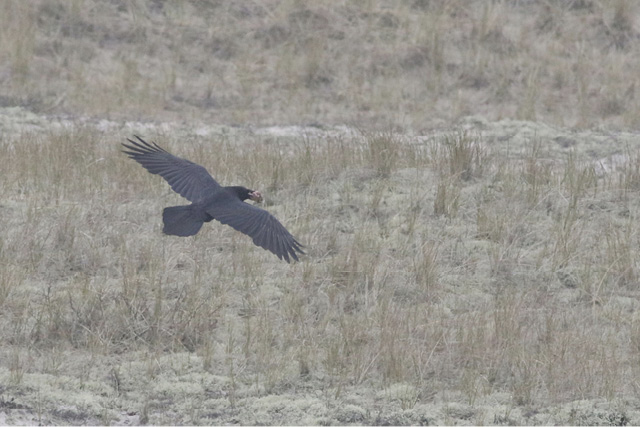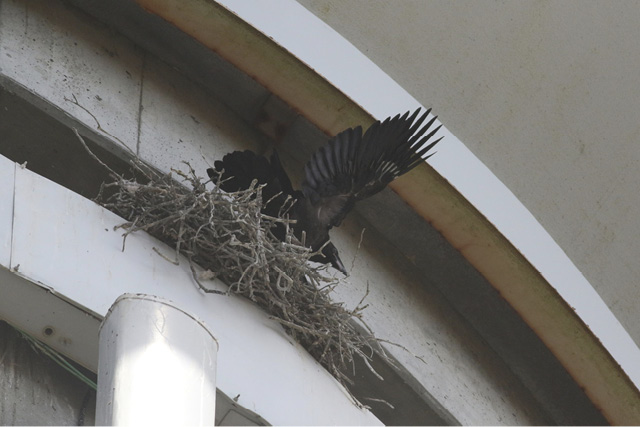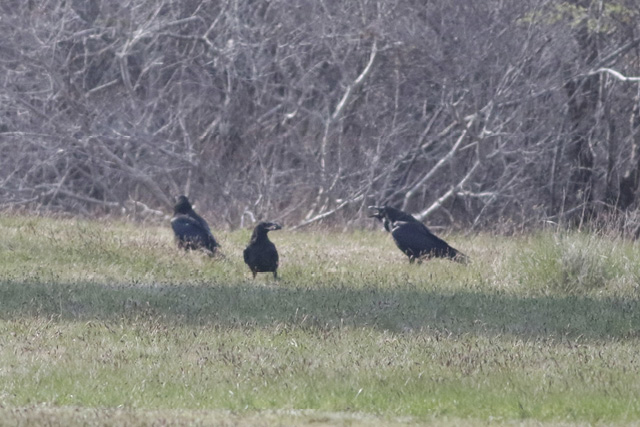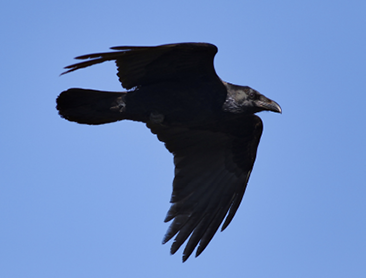Skyler Kardell

One of the adult ravens flies from the water tower to Low Beach to collect a piece of rabbit carcass. All photos by Skyler Kardell.
Editor’s Note: For Bird Observer online, click on the underscored dates to see the eBird reports.
For a number of years, Common Raven (Corvus corvax)—along with Eastern Screech-Owl (Megascops asio) and Red-shouldered Hawk (Buteo lineatus)—was put on a short list of birds that can be found on the mainland but are absent from Martha’s Vineyard and Nantucket Island. Prior to 2019, there was only one confirmed record of Common Raven for Nantucket County—a bird seen and photographed by several observers at the Milestone Cranberry Bogs on February 22, 2014. Coincidentally, the second documented record for the island was found less than a mile away from the bogs on August 18, 2019. The prospect of ravens breeding on Nantucket was laughable then. Yet that is the reality in 2021.
Ravens had disappeared in Massachusetts by the early twentieth century, having lost much of their former range in New England due to clear-cutting for agriculture among other causes, and did not reappear until the 1940s (Boarman and Heinrich 2020). It would take another 30 years for the species to populate the Northeast again. At the time of publication of The Birds of Massachusetts in 1993, the status of Common Raven in the eastern part of the state was rare, although it bred in western Massachusetts (Veit and Peterson 1993). By 2013, the Massachusetts Breeding Bird Atlas 2 reported ravens present and breeding statewide—except for Cape Cod and the Islands (Walsh and Petersen 2013). The species’ expansion into the coastal plain is still a recent phenomenon. Only within the last decade have ravens returned to Cape Cod (eBird 2013–2021), where in the early seventeenth century, pilgrim colonizers had reported them as numerous (Veit and Petersen 1993).
Nantucket and Martha’s Vineyard added Common Raven to their respective county lists within a period of two months in 2014, but Common Ravens bred first on Martha’s Vineyard before they nested on Nantucket. After Adam Burnett found the first Dukes County record on April 20, 2014, in Chappaquiddick, observers around the island started turning up new reports, perhaps of the same bird. On November 4, 2016, a raven was seen for the first time in West Tisbury. Robert Culbert observed one at the Martha’s Vineyard State Forest on September 2, 2017. On December 29, 2018, the species was documented at Vineyard Haven for the first time, after five had been seen at a nearby farm. The Vineyard ravens first nested on a mid-island radio tower in 2018 and have subsequently nested there in 2019 and 2020, producing between two and three chicks that have fledged. Unfortunately, they have not been successful in raising any young in 2021.
Common Ravens are rare or infrequent visitors to other small, low-lying islands in our region, such as the Elizabeth Islands. On Cuttyhunk, a group of birders documented the first eBird record for the island on October 28, 2017. Even Monomoy Island, Barnstable County, which is closer to shore than the majority of islands of Dukes County, has just one documented record, from 2019.
On May 8, 2019, Nantucket birders were put on high alert for an undocumented report of Common Raven at the Sankaty Golf Club in Siasconset. The bird was being mobbed by American Crows, and presumably calling as well. Over the next several weeks, local birders searched for this rarity in vain and began to dismiss the chances of seeing a Nantucket raven as “nevermore.” That changed on August 17, when Kenneth Blackshaw observed a raven flying beneath the cliff face at Baxter Road. Unable to refind the bird later that day, Blackshaw and several other observers went out to look for the bird on August 18 and photographed it nearly a mile west of the Milestone Cranberry Bogs. For the next three days, the bird again disappeared from the public eye. Tensions eased on August 22 when Lee Dunn had a bird flying east over his mid-island residence at 7:05 pm. The raven was exceptionally vocal, which would make it easy to detect if it continued calling.
September 2019 was characterized by multiple raven sightings across the west half of the island. Two birds were seen at Jackson Point on September 1, riding west on a thermal and being harassed by nearby Ospreys. This record confirmed the existence of two separate birds on Nantucket, rather than just one seen during August. On September 3, a few observers at Sanford Farm noted a single bird flying in circles above the property and vocalizing regularly. Most September records for Nantucket were of single birds, although one observer at North Head of Long Pond had two birds fly east over his house at around 6:30 pm every evening for the latter half of the month. This journey was likely a daily commute for these birds, flying between foraging grounds on the west half of the island and an unknown roost somewhere to the east. An observer in the Mizzenmast area also noted two ravens at approximately 5:40 pm on September 16, indicating that the roost site may have even been farther east than Miacomet Pond.

A precarious balancing act: one of the young birds flaps its wings at the observers below.
For the month of October, the ravens seemingly disappeared—again. The only eBird records for this species in October 2019 come from the Nantucket Wildlife Refuge, where two observers independently observed a raven on the outer beach of Coskata just a half-mile apart on October 1. One observer noted that it was feeding on a gull carcass.
On November 1, two birders watched both ravens calling and foraging over a field just on the outskirts of Siasconset Village. Perhaps this pair was prospecting the suitability of the water tower there as a future potential nesting site. The birds were seen within the immediate vicinity of the water tower through November 10, where they were observed several times calling from on top of the structure. Several sightings from November 9 through the end of the month raised the question: Could there be more than two Common Ravens on Nantucket?
Hopes were high that the 2019 Christmas Bird Count on December 29 would shed some light on the true number of ravens on Nantucket. However, when the day finally came around, with 52 birders putting in 95 hours of search time, only one Common Raven was found throughout the entire island (National Audubon Society 2019). This came as a surprise to many, especially when just a few weeks before, on December 10, Blair Perkins had both birds at Low Beach, where they had been seen often. The Tuckernuck Christmas Bird Count did not reveal anything either. Finally, on January 12, 2020, a group of mainland birders saw one raven flying over Milestone Road. On January 18, both birds were seen again at the water tower and hopping down onto Milestone Road to pick up roadkill scraps. It is likely that the birds spent the majority of February and March 2020 commuting between the water tower and foraging sites in Coskata, as evidenced by several sightings of both or single birds flying north from Siasconset at or before dawn, and then flying south early in the morning along the eastern shore. During the winter, large numbers of alcids wash up along this stretch of shore between Great Point and Coskata, especially after strong northeast winds. It is possible that the ravens were being opportunistic with these strandings and feeding on carrion during this time.

For the first few days after fledging, the two juveniles joined the adults in the fields next to the water tower.
In late March, suspicions of nesting ravens on Nantucket were confirmed when Edie Ray spotted a nest on the southeast side of the Siasconset water tower. Situated on a south-facing berm directly below the water tower’s cup, the nest was spared from some of the harsh northwest winds that deliver cold, dry air from the mainland at this time of year. On April 30, a young bird was clearly observed in the nest through a scope on Low Beach. Whitewash began to appear on both sides of the nest, indicating that the adults were no longer incubating. At least one parent was frequently flying from the water tower to a select spot in the dunes of Low Beach, carrying a chunk of dead rabbit each time it returned to the nest.
On May 7, it was discovered that one of the young birds had fallen out of the nest and had died on the gravel below. Judging by the state of the specimen, it was likely that this fatality occurred a few days earlier. By May 11, the two remaining chicks fledged and joined the adults in the fields below the water tower. The family group remained in the fields while the juveniles became more independent and bolder in their actions. All four ravens were still there for Mass Audubon’s annual Bird-a-Thon on May 16, 2020. With no large mammalian ground predators on Nantucket, the survival of the two juveniles seemed imminent. It would be up to local birders to find out whether or not they would stay on the island into the winter.
After the ravens fledged, local birders and conservation groups started questioning the fate of beach-nesting shorebirds. The addition of Common Ravens to the Nantucket avifauna could potentially spell disaster for the tern colonies at Low Beach or Coskata. In a Californian study, local ravens were the cause of 1.2% of depredations of Least Tern eggs over a 10-year period (Boarman and Heinrich 2020). Fortunately, in 2020 on Nantucket, no such issues materialized. A few weeks after the chicks fledged, the raven family moved to the nearby Milestone Cranberry Bogs to forage.

Two birds, presumably the juveniles, returned to Tuckernuck for the first week in October.
A major development in the raven saga on Nantucket occurred on June 8, 2020, when an observer in the Milestone Cranberry Bogs saw not four, but six Common Ravens—presumably the resident family group in addition to an unknown pair. It is possible that the unknown pair arrived sometime in the late summer of 2019, which would have accounted for the large number of raven sightings in September of that year. It is equally possible that this pair arrived on Nantucket during spring 2020 and was not detected until June 8. Either way, the local birding community did not expect this sudden increase in raven numbers. On June 15, presumably the same group of six birds was seen flying west over North Head of Hummock Pond, and the observer picked up the two juvenile call notes from the cacophony of caws and croaks. That was the last reported sighting of six ravens together in 2020.
For much of July, the raven family was foraging at the Madaket Landfill. It is possible that the family group continued to commute between the landfill and the nest site at the Siasconset Water Tower, because several reports during the summer had the birds well east of the landfill, and one sighting on August 23 has a solo raven at the Milestone Cranberry Bogs.
In September, the ravens apparently discovered the existence of Tuckernuck, an island off the coast of Nantucket. The family group of four was first spotted there on September 5, when they were seen flying across Madaket Harbor from Nantucket around 8:00 am. The birds spent the remainder of the morning on the west side of Tuckernuck. Around noon, they took off for the east, presumably back toward Nantucket. The day before this sighting, September 4, all four ravens were observed at Norwood Farm on Nantucket. The distance between Norwood Farm and the eastern half of Tuckernuck is approximately 12 miles and includes a rough 2.5-mile stretch of water between Madaket on Nantucket and Whale Point on Tuckernuck. Again on September 27, the four ravens arrived on Tuckernuck in the early morning hours, and departed by midafternoon, having foraged around the west end for the majority of the day.
Two of the birds continued foraging on Tuckernuck for the early part of October. On October 6, both ravens were seen flying west in a thermal at a considerable altitude. It is possible that these birds continued out toward Muskeget. They appeared again on Tuckernuck briefly for part of the day on October 9. Whether the two birds that stayed on Tuckernuck in October were the remaining adults or the two juveniles is unknown. Regardless, no more than two ravens were seen on Nantucket or Tuckernuck islands after that time for the remainder of 2020 until December 27, the date of the Nantucket Christmas Bird Count. With 40 birders putting in over 140 hours of observation time, four individual ravens were confirmed throughout Nantucket Island (National Audubon Society 2020).
Fast forward to spring of 2021: both parents returned to nest in the same location on the water tower as they did in 2020. The reproductive success was better than in 2020. In 2021, a complete clutch of three chicks survived into fledglings. Reactions to the current status of Common Ravens on Nantucket have been mixed. While some birders welcome the presence of these birds, others fear that the long-term effects could be detrimental for the summer population of Piping Plovers, Least Terns, and American Oystercatchers that nest on the island’s east end. One priority for studying the Common Ravens nesting on Nantucket should be to track the daily foraging patterns of these birds, because it is unclear where or if these birds explore outside the Milestone Cranberry Bogs or Madaket Landfill during the summer. Some members of the community were convinced that the nesting of the ravens in 2020 would be a one-off event, quite like the Eastern Screech-Owls that nested in Siasconset in the mid-1940s (Griscom and Folger 1948). For now, Common Ravens on the islands seem here to stay.
Citations
- Boarman, W. I. and B. Heinrich. 2020. Common Raven (Corvus corax), version 1.0. In Birds of the World (S. M. Billerman, Editor). Cornell Lab of Ornithology, Ithaca, NY, USA. https://doi.org/10.2173/bow.comrav.01Accessed June 2, 2021.
- eBird. 2014–2021. eBird: An online database of bird distribution and abundance [web application]. eBird, Cornell Lab of Ornithology, Ithaca, New York. Available: http://www.ebird.org. Accessed June 4, 2021.
- Griscom, Ludlow, and Edith V. Folger. 1948. The Birds of Nantucket. Cambridge, Massachusetts: Harvard University Press.
- National Audubon Society. 2019. The Christmas Bird Count Historical Results [Online]. Available http://www.christmasbirdcount.org. Accessed June ٠٢, ٢٠٢١.
- National Audubon Society. 2020. The Christmas Bird Count Historical Results [Online]. Available http://www.christmasbirdcount.org. Accessed June ٠٢, ٢٠٢١.
- Veit, Richard R. and Wayne R. Petersen. 1993. Birds of Massachusetts. Lincoln, Massachusetts: Massachusetts Audubon Society.
- Walsh, J. M. and W. R. Petersen. 2013. Massachusetts Breeding Bird Atlas 2. Lincoln, Massachusetts: Massachusetts Audubon, (Published by Scott and Nix).
Skyler Kardell is a second-generation Nantucketer and a rising freshman at Connecticut College in New London. He is the coastal steward for the Tuckernuck Land Trust. Skyler is a regular participant on the Nantucket Christmas Bird Count and several local bird-a-thons.